How to Feed Your Sporting Dog
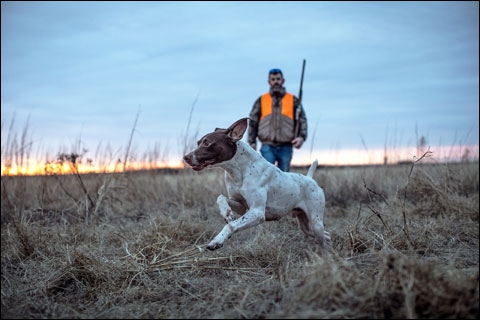
Canine nutritionists have long known that nutrition is key to performance, but how much and when we feed our dogs is just as important as what we feed. These factors can impact your dog’s energy levels, physical fitness, and post-hunt recovery. Here is what you need to know to help keep your sporting dog in top form throughout the year.
This article is in partnership with Eukanuba™ Premium Performance Dry Dog Food
How to Feed Your Sporting Dog
Written by Ryan Sparks
Canine nutritionists have long known that nutrition is key to performance, but how much and when we feed our dogs is just as important as what we feed. These factors can impact your dog’s energy levels, physical fitness, and post-hunt recovery. Here is what you need to know to help keep your sporting dog in top form throughout the year.
Determining a Body Condition Score
Just like professional athletes, how much our dogs eat varies throughout the year. They obviously don’t need as much food during periods of light offseason training as during the heart of the hunting season. So how can you determine how much food your dog needs throughout the year? The feeding guidelines listed on the bag are a good starting point, but a body condition score will give you a more accurate idea and can be performed throughout the year.
A body condition score is a way to determine if your dog is overweight, underweight, or at an ideal weight. To perform a body condition score you need to examine three areas of your dog: a rib check, profile check, and overhead check.
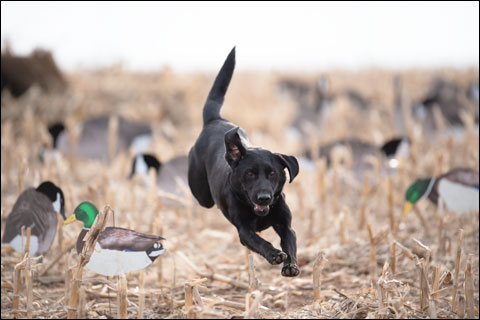
1. Rib Check: Run your finger over your dog’s rib cage. You should be able to feel individual ribs. If you need to push in with your finger to find a rib, your dog is carrying too much weight. If the ribs are clearly visible and stick out, it could mean the dog needs more calories in their diet.
2. Profile Check: Get on the same level as your dog while they are standing and examine their profile from the side. You should see a tuck around their abdomen. If their abdomen appears expanded, the dog is overweight.
3. Overhead Check: Stand directly above your dog. The dog’s waist should be clearly visible, with a slight taper from the shoulders to the waist. If the dog’s pelvic bones jut out prominently, the dog is likely underweight.
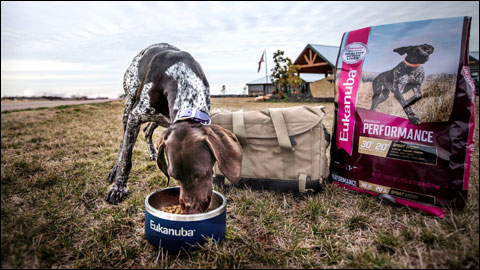
Considering how your dog scores in these areas will give you a good baseline to determine her caloric needs. If you have any questions, consult your veterinarian.
Make Calories Count
Ready for some math? Canine nutritionists use a simple formula to determine a dog’s basic caloric needs. First, take your dog’s ideal weight and divide it by 2.2 to convert it to kilograms. Then raise the dog’s weight to the ¾ power and multiply by 70.
Keep in mind that basic caloric needs are what your dog needs as a baseline. As your dog’s workload increases so should their caloric intake. For light work, multiply the daily caloric needs by a maximum of 2. For moderate work, multiply by 3. For hard days in harsh conditions, multiply by up to 6.
Here’s an example for a 50-pound dog.
- 729 calories (basic daily caloric needs) times 2 = 1,458 calories per day for light work.
- 729 calories times 3 = 2,187 calories per day for moderate work.
- 729 calories times 6 = 4,374 calories per day for hard work.
Finally, divide the number of calories your dog needs by the kilocalories (kcals) per cup listed on your dog food packaging. This will give you an accurate idea of how much to feed your dog based on their activity level.
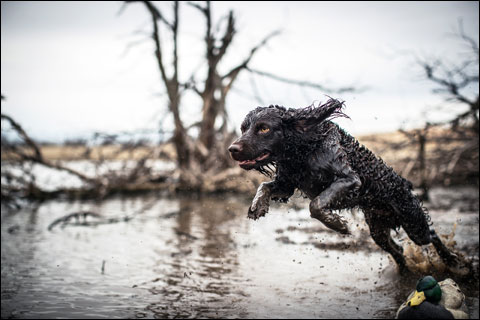
Scheduled Feeding
Meal timing is almost as important as the meal itself. Hardworking gundogs should be fed twice a day. In the morning they should eat 1/3 of their daily feed at least 3 hours before conditioning, training, or a hunt. The gap between eating and running gives them time to digest their food and absorb nutrients—essentially stockpiling fuel for the exercise to come. The remaining 2/3 of their food should come at least two hours after their exercise. This allows a dog’s body temperature to return to normal.
Consider a Performance Dog Food Optimized for Your Dog’s Activity Level
The diet you choose to feed your dog can have a big impact on their ability to perform at their peak. Diets like Eukanuba’s Premium Performance formulas are made from high quality ingredients that are nutritionally dense. They provide an optimal balance of carbohydrates, protein, fat, minerals, vitamins, and antioxidants to help your dog maximize his potential.
Another factor to consider is matching dietary energy sources to your dog’s activity level. Some dogs need fuel for quick, intense bursts of activity which comes from carbohydrates. Others need a diet with more fat for endurance to help them along their half or full day’s work. The range of carbohydrates, protein and fat found in Eukanuba’s Premium Performance formulasoffers a tailored approach to fueling your dog with the energy he needs.

Feeding your dog isn’t difficult, but it’s not as simple as pouring kibble into a bowl. Regular feeding along with keeping an eye on their body condition helps keep dogs fit and ready to perform.
Ryan Sparks is an award-winning outdoor writer and photographer. Before becoming Strung’s Editor-in-Chief he worked as a full-time freelancer, serving as Wild Foods Editor for Strung, Media Editor for American Angler, was a Senior Contributor to both Tail Fly Fishing Magazine and Nebraskaland, and worked as the Senior Writer and Photographer for Approach Media. His freelance work has appeared in dozens of publications including Gray’s Sporting Journal, The Flyfish Journal, The Drake, and MeatEater, among others. He loves fly fishing for anything that swims, hunting with a bow, and following his pointers across the country.
Useful resources:
The web site for Eukanuba’s Premium Performance formulas

Ryan Sparks is an award-winning outdoor writer and photographer. Before becoming Strung’s Editor-in-Chief he worked as a full-time freelancer, serving as Wild Foods Editor for Strung, Media Editor for American Angler, was a Senior Contributor to both Tail Fly Fishing Magazine and Nebraskaland, and worked as the Senior Writer and Photographer for Approach Media. His freelance work has appeared in dozens of publications including Gray’s Sporting Journal, The Flyfish Journal, The Drake, and MeatEater, among others. He loves fly fishing for anything that swims, hunting with a bow, and following his pointers across the country.

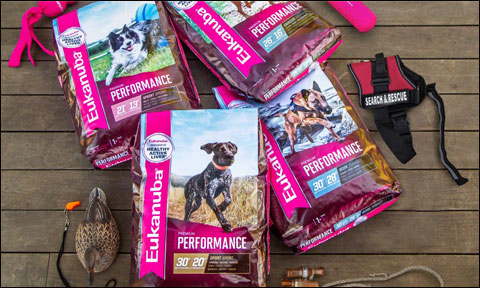

Comments